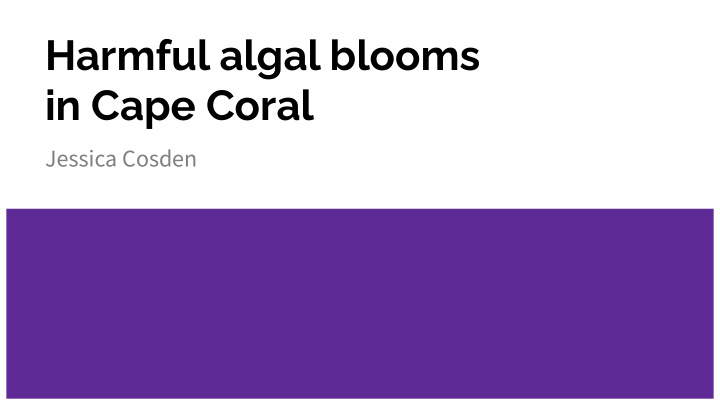



Harmful algal blooms in Cape Coral Jessica Cosden
Hi, I’m Jessica! Lifelong resident, mother of 3 ● Councilmember elected in 2015 ● Running for re-election ● Not a scientist ; just a very concerned ● citizen
Cape Coral has 400 miles of ● human-made canals, is surrounded by water on 3 Why is this issue sides Every resident lives less than so important to ● half a mile from water me? My family’s health ● Our economy ● Our environment ●
What is Occurs in salt/fresh water ● Normal levels are safe ● cyanobacteria Conditions for overgrowth: stagnant ● water, high temperatures, nutrients (a.k.a. During bloom: smelly, ugly, and ● microcystins released into the air blue-green algae?
Short term effects: mostly respiratory ● Long term effects? University of Miami ● scientists found that dolphins that had come into contact with blue-green algae toxins displayed degenerative brain damage similar to Alzheimer’s, Lou Health impacts Gehrig’s disease and Parkinson’s in humans. Air quality testing underway in Cape ● Coral and elsewhere
2018: double whammy (red tide ● and blue-green algae) Many Florida cities saw the same ● thing Gov. Scott declared state of ● emergency in 7 counties, Outbreaks including Lee Current outbreak: blooms in 3 ● landlocked Cape Coral canals (2 adjacent to golf course, third within 2 miles of same golf course)
Andrew Gillum - Yacht Club, August 2018
● Reduce/eliminate discharges ● from Lake Okeechobee Enhance fertilizer ordinance ● Prevention Convert septic tanks to sewer ● Pet waste ● (the one thing Use natural or man-made ● we can control: filtration before stormwater hits canals nutrients) Reduce nutrients in irrigation ● water
● Clay spray ● Barriers ● Other methods Treatments
“Flocculation” ● Non-toxic, approved by ● Florida Department of Environmental Protection Dry clay mixed with water, ● sprayed directly into canal Clay Clay binds with algae, falls to ● bottom Used widely in Asia, being ● tested here in Cape Coral
● Turbidity curtains ● Bubble curtains ● Booms (Cape Coral Fire Department used these Barriers during 2018 outbreak)
Foams/sponges ● Suction -- in 2018, AECOM ● pulled 190,000 gallons of algae slurry out of 11 Cape Coral canals Methods that kill cyanobacteria ● algae in the water Other methods Any product used must be ● approved by FL DEP, as the canals are considered state waters
Algal bloom tracker Source: Florida Department of Environmental Protection https://floridadep.gov/AlgalBloom (Image captured 9/4/20)
Contact Jessica Cosden jessicacosden@gmail.com www.JessicaCosden.com 239.770.5046
Recommend
More recommend